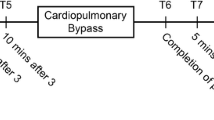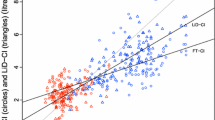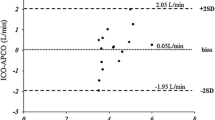Abstract
The pulmonary artery catheter (PAC)—despite its invasiveness—remains the gold standard for cardiac output (CO) monitoring. The FloTrac system, a less invasive hemodynamic monitor has been developed, which estimates CO using arterial pressure waveform analysis without external calibration. Recently, an upgraded version of FloTrac system with improved algorithm to follow changes in vascular resistance was introduced into the market. The aim of this study was to assess the reliability of the CO estimated from the fourth-generation FloTrac/EV1000 system (COFT) compared to that measured with PAC using the thermodilution method (COPAC) during robotic-assisted off-pump coronary artery bypass (OPCAB) surgery. COFT and COPAC were obtained simultaneously at 4 predefined time points during robotic-assisted OPCAB: 5 min after the induction of general anesthesia (T1), after starting one-lung ventilation (T2), after capnothorax (T3), and after mini-thoracotomy was performed (T4). The agreement of data was investigated by Bland–Altman analysis. Thirty-four patients were initially enrolled. After exclusion, 32 patients and a total of 128 paired CO measurements were obtained. The overall bias was 1.46 L/min, the 95% limits of agreements were − 3.40 to 6.33 L/min, and the percentage error was 72.98%. Regression analysis of the systemic vascular resistance index (SVRI) and the bias between COPAC and COFT showed that the bias was moderately correlated with the SVRI (r2 = 0.43; p < 0.0001). Despite a software upgrade, the reliability of the fourth-generation FloTrac/EV1000™ system during robotic-assisted OPCAB to estimate CO was not acceptable, especially in patients with low SVRI.



Similar content being viewed by others
References
Whellan DJ, McCarey MM, Taylor BS, Rosengart TK, Wallace AS, Shroyer AL, Gammie JS, Peterson ED (2016) Trends in robotic-assisted coronary artery bypass grafts: a study of the society of thoracic surgeons adult cardiac surgery database, 2006 to 2012. Ann Thorac Surg 102:140–146
Yanagawa F, Perez M, Bell T, Grim R, Martin J, Ahuja V (2015) Critical outcomes in nonrobotic vs robotic-assisted cardiac surgery. JAMA Surg 150:771–777
Do QB, Goyer C, Chavanon O, Couture P, Denautt A, Cartier R (2002) Hemodynamic changes during off-pump CABG surgery. Eur J Cardiothorac Surg 21:385–390
Funk DJ, Moretti EW, Gan TJ (2009) Minimally invasive cardiac output monitoring in the perioperative setting. Anesth Analg 108:887–897
Ganz W, Donoso R, Marcus HS, Forrester JS, Swan HJ (1971) A new technique for measurement of cardiac output by thermodilution in man. Am J Cardiol 27:392–396
American Society of Anesthesiologists Task Force on Pulmonary Artery Catheterization (2003) Practice guidelines for pulmonary artery catheterization: an updated report by the American society of anesthesiologists task force on pulmonary artery catheterization. Anesthesiology 99:988–1014
Seifi A, Elliott RJ, Elsehety MA (2016) Usage of Swan-Ganz catheterization during the past 2 decades in United States. J Crit Care 35:213–214
Suehiro K, Tanaka K, Funao T, Matsuura T, Mori T, Nishikawa K (2013) Systemic vascular resistance has an impact on the reliability of the Vigileo-FloTrac system in measuring cardiac output and tracking cardiac output changes. Br J Anaesth 111:170–177
Maeda T, Yoshitani K, Inatomi Y, Ohnishi Y (2014) Inaccuracy of the FloTrac/Vigileo system in patients with low cardiac index. J Cardiothorac Vasc Anesth 28:1521–1526
Suehiro K, Tanaka K, Mikawa M, Uchihara Y, Matsuyama T, Matsuura T, Funao T, Yamada T, Mori T, Nishikawa K (2015) Improved performance of the fourth-generation flotrac/vigileo system for tracking cardiac output changes. J Cardiothorac Vasc Anesth 29:656–662
Bland JM, Altman DG (1986) Statistical methods for assessing agreement between two methods of clinical measurement. Lancet 1:307–310
Critchley LA, Critchley JA (1999) A meta-analysis of studies using bias and precision statistics to compare cardiac output measurement techniques. J Clin Monit Comput 15:85–91
Kusaka Y, Ohchi F, Minami T (2019) Evaluation of the fourth-generation FloTrac/Vigileo system in comparison with the intermittent bolus thermodilution method in patients undergoing cardiac surgery. J Cardiothorac Vasc Anesth 33:953–960
Eisenried A, Klarwein R, Ihmsen H, Wehrfritz A, Tandler R, Heim C, Fechner J (2019) Accuracy and trending ability of the fourth-generation FloTrac/EV1000 system in patients with severe aortic valve stenosis before and after surgical valve replacement. J Cardiothorac Vasc Anesth 33:1230–1236
Ylikauma LA, Ohtonen PP, Erkinaro TM, Vakkala MA, Liisanantti JH, Satta JU, Juvonen TS, Kaakinen TI (2022) Bioreactance and fourth-generation pulse contour methods in monitoring cardiac index during off-pump coronary artery bypass surgery. J Clin Monit Comput 36(3):879–888
Cho YJ, Koo CH, Kim TK, Hong DM, Jeon Y (2016) Comparison of cardiac output measures by transpulmonary thermodilution, pulse contour analysis, and pulmonary artery thermodilution during off-pump coronary artery bypass surgery: a subgroup analysis of the cardiovascular anaesthesia registry at a single tertiary centre. J Clin Monit Comput 30:771–782
Maeda T, Hamaguchi E, Kubo N, Shimokawa A, Kanazawa H, Ohnishi Y (2019) The accuracy and trending ability of cardiac index measured by the fourth-generation FloTrac/Vigileo system™ and the fick method in cardiac surgery patients. J Clin Monit Comput 33:767–776
Mayer J, Boldt J, Poland R, Peterson A, Manecke GR Jr (2009) Continuous arterial pressure waveform-based cardiac output using the FloTrac/Vigileo: a review and meta-analysis. J Cardiothorac Vasc Anesth 23:401–406
Lorsomradee S, Lorsomradee S, Cromheecke S, De Hert SG (2007) Uncalibrated arterial pulse contour analysis versus continuous thermodilution technique: effects of alterations in arterial waveform. J Cardiothorac Vasc Anesth 21:636–643
Scolletta S, Franchi F, Taccone FS, Donadello K, Biagioli B, Vincent JL (2011) An uncalibrated pulse contour method to measure cardiac output during aortic counterpulsation. Anesth Analg 113:1389–1395
Matsuura K, Imamaki M, Ishida A, Shimura H, Fujita H, Niitsuma Y, Miyazaki M (2008) Low systemic vascular resistance state following off-pump coronary artery bypass grafting. Ann Thorac Cardiovasc Surg 14:15–21
Suehiro K, Tanaka K, Yamada T, Matsuura T, Mori T, Funao T, Nishikawa K (2015) The ability of the Vigileo-FloTrac system to measure cardiac output and track cardiac output changes during one-lung ventilation. J Clin Monit Comput 29:333–339
Tsai YF, Su BC, Lin CC, Liu FC, Lee WC, Yu HP (2012) Cardiac output derived from arterial pressure waveform analysis: validation of the third-generation software in patients undergoing orthotopic liver transplantation. Transplant Proc 44:433–437
Acknowledgements
We offer special thanks to Dr. Shu-Wei Wang and Yung-Chu Teng for their excellent assistance in writing and revising the draft of this manuscript. We also express our gratitude to Prof. Yen Chang and Dr. Chung-Yu Lo who performed the surgery and cared for the patients in this study. This article was edited by American Journal Experts (AJE).
Author information
Authors and Affiliations
Corresponding author
Ethics declarations
Conflict of interest
The authors declare that they have no conflict of interest.
Ethics approval
Approval was obtained from the Institutional Review Board of Taipei Tzu Chi Hospital (IRB No.10-XD-005). The procedures used in this study adhere to the tenets of the Declaration of Helsinki.
Additional information
Publisher's Note
Springer Nature remains neutral with regard to jurisdictional claims in published maps and institutional affiliations.
Rights and permissions
Springer Nature or its licensor holds exclusive rights to this article under a publishing agreement with the author(s) or other rightsholder(s); author self-archiving of the accepted manuscript version of this article is solely governed by the terms of such publishing agreement and applicable law.
About this article
Cite this article
Wu, NH., Hsieh, TH., Chang, CY. et al. Validation of cardiac output estimation using the fourth-generation FloTrac/EV1000™ system in patients undergoing robotic-assisted off-pump coronary artery bypass surgery. Heart Vessels 38, 341–347 (2023). https://doi.org/10.1007/s00380-022-02177-x
Received:
Accepted:
Published:
Issue Date:
DOI: https://doi.org/10.1007/s00380-022-02177-x




